What are the primary substation feeders? How to analyze their arrangements? | EEP
Mục Lục
Substation feeder definition
A feeder carries energy to a substation or bus or to several loads. The several substation feeder arrangements are discussed in this technical article. Feeder may connect two substation buses in parallel to provide stiffness or service continuity for the load supplied from each bus. If either source has plant generation, then the tie feeder maintains the two parts of the system in synchronism and provides a circuit for transferring normal power and kilovars in either direction between the sources.

The primary feeders that supply load-center unit substations are not included as further arrangements because they are fundamentally radial feeders. A loop feeder also has its extremities connected to a source (usually a single source), but its main function is to supply two or more load points between. Each load point can be supplied from either direction.
So it is possible to remove any section of the loop from service without causing an outage at any load point.
Radial feeders
A radial feeder connects between a source and a load point, and it may supply one or more additional load points between. If the connection to an intermediate load point is an ‘in-and-out‘ or ‘loop‘ connection instead of a tap, the feeder does not, of course, assume loop characteristics in as much as each load point can be supplied from one direction only.

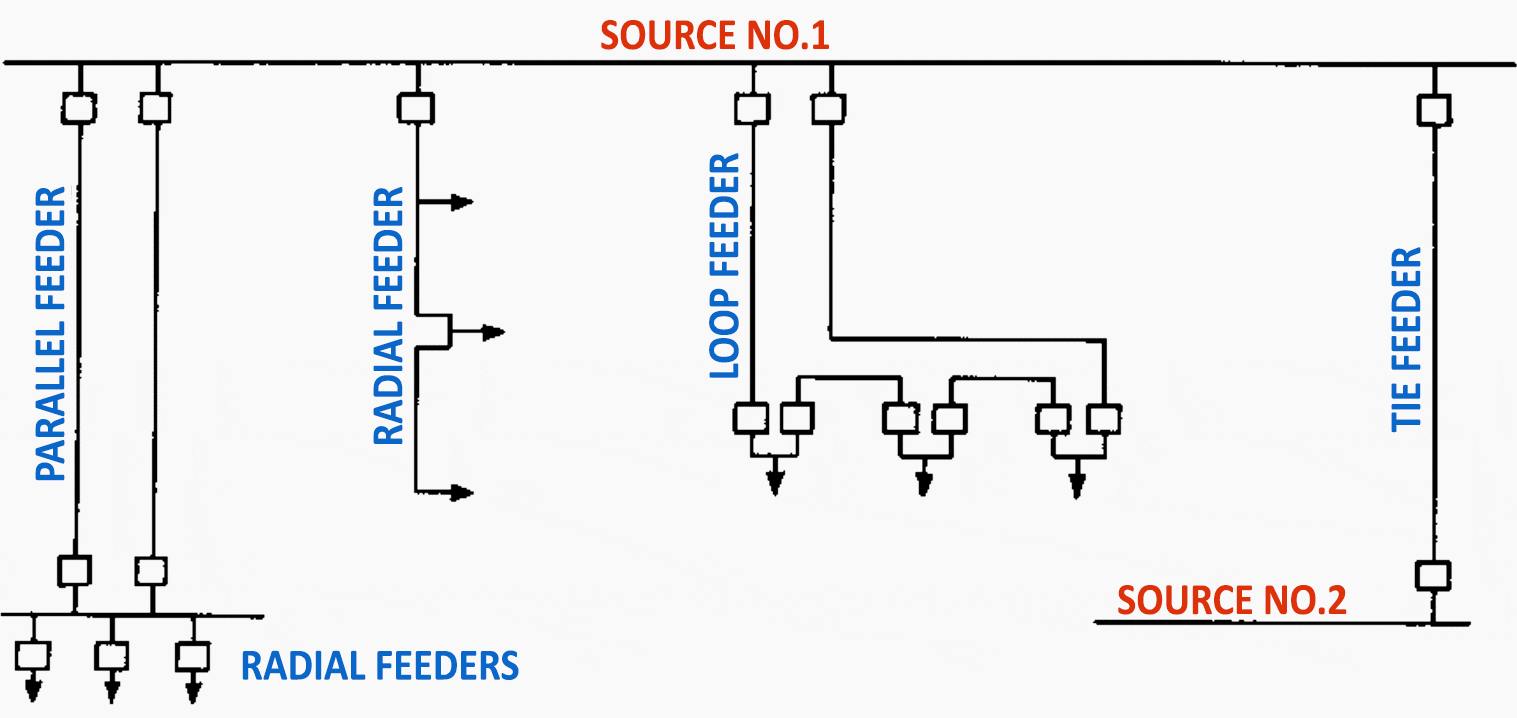
Radial feeders are the most widely used because they are simple, easy to protect, and low in cost. They are simple because there is only one path for current to any given load point. They are easily protected by simple overcurrent relays at the supply circuit breaker.
The cost is low because there is no duplication of equipment. These comments apply to ‘single’ radial feeders and not to ‘parallel’ feeders which have characteristics resembling those of loop feeders.
Parallel feeders
Parallel feeders consist of two or more feeders bused together (connected at the same bus) both at the sending and receiving ends. It is sometimes more economical to design a heavy cable circuit with two or more cables in parallel, but these cables cannot be considered as parallel feeders when single-circuit switching equipment is used.
Parallel feeders as illustrated by Figure 1 provide a high degree of service reliability, or continuity, if one of several methods of protecting parallel lines is employed. This protection is more complicated and expensive than the simple overcurrent protection ordinarily installed in single radial feeders.
Separated circuits are desirable, and each will typically have the ability to handle the normal load with the other circuit out of service. Additional circuit breakers are needed. In general, four circuit breakers are required for parallel feeders supplying one load point, while only one circuit breaker is needed for a single radial feeder.
There are obviously some heavy cost penalties against the parallel-feeder arrangement. Its excellent characteristics can be justified only for serving large loads such as sub-distribution buses or smaller loads with unusual service requirements.
Several variations intended to improve upon the performance of single radial feeders have costs below those for parallel feeders. They all sacrifice service continuity as a characteristic. For particular requirements, one or another of these variations may be a preferred solution, but they tend in general to have questionable value.
One variation is to use a conventional parallel-feeder scheme, but to use overcurrent protection only. This does not represent an important saving, and a short, circuit in either line interrupts service. Moreover, the fault location is not indicated, and considerable time may be spent in finding which line is in trouble unless it is considered acceptable to take the chance of closing again on the same fault.
A second variation is like the one above, except that one of the two circuits is operated normally open and is held as an alternate or reserve feeder. The equipment is the same, and the only advantage is that the fault location is indicated when service is interrupted.
A third variation makes a further saving by using a total of four circuit-breaker positions, but only two circuit breakers. The performance is similar to that of the second variation except that the outage will be longer to allow extra time to move the circuit-breaker elements.
Circuit-breaker maintenance without service interruption requires that two spare circuit-breaker be available.

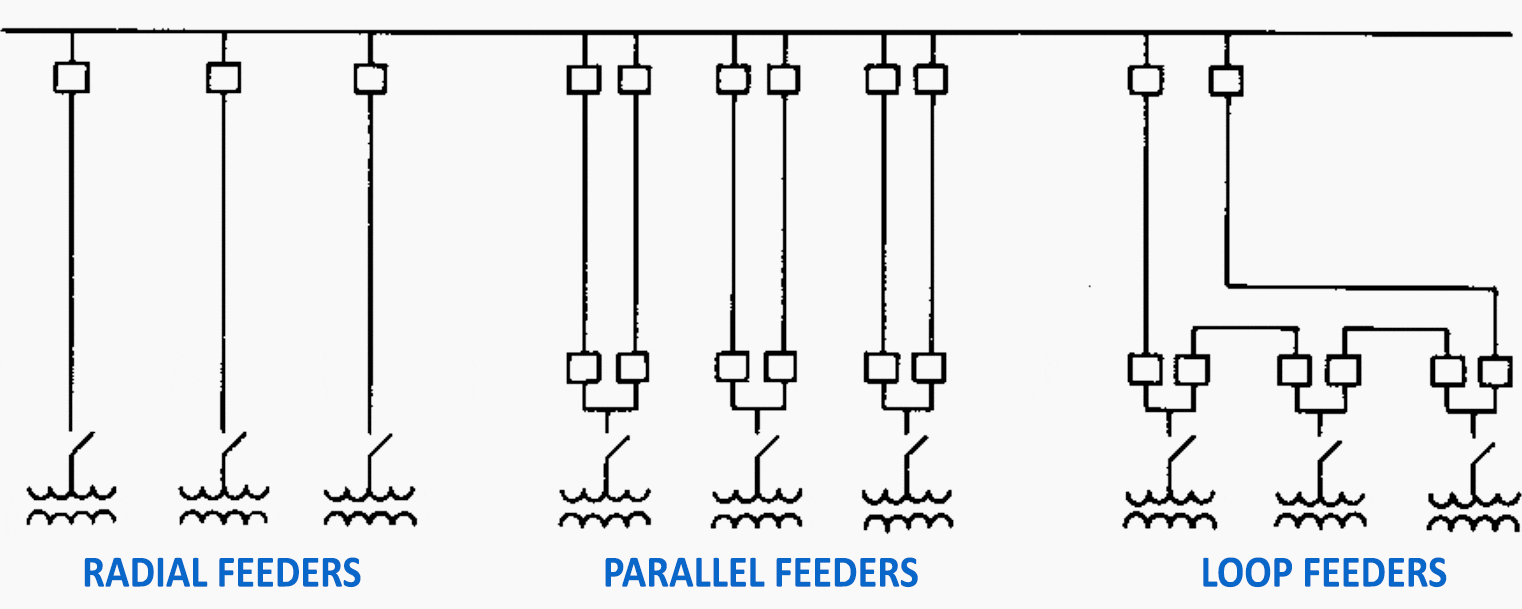
Figure 2 is included in combination with Table 1 to lead into a discussion of loop feeders. Three load points are arbitrarily selected for comparing the number of cables and circuit breakers necessary for each of the three feeder arrangements illustrated.
Table 1 then indicates how large the cost differences might be without considering any differences in protection costs.
Table 1 – Circuit breakers and typical amounts of cable required for supplying N load points by the three feeder arrangements shown in Figure 2
Radial
feedersParallel
feedersLoop
feederNumber of circuit breakersN4N2N+2Cable current ratingIINICable footageL2L0.5L to 1.5L
Loop feeders
Loop feeders perform much the same as parallel feeders, and the operating features can usually be obtained at less cost for the two or more load
points. But this is still a high-cost feeder system that will prove economically sound in about the same kinds of situations where parallel feeders can be justified.
Loop feeders look so attractive to many engineers that variations with lower costs are often considered and sometimes adopted. Most of these arrangements only resemble good loop systems and can be analyzed into positions of lower value than radial arrangements of still lower costs.
Before examining any of these arrangements, there should be an understanding of the kind of equipment needed in a loop feeder to produce the
characteristics associated with it.
A loop feeder is intended to provide service continuity. It must therefore be operated normally closed and must have two sectionalizing circuit breakers at each load point. These breakers must be adequate for interrupting system short circuits, and they must be a part of a complete protective system, including the source circuit breakers, so that any faulty section of the loop can be automatically removed from service without dropping any load.
The preferred loop relaying is wire-pilot differential. Directional overcurrent is slower but may be attempted to reduce costs if there are only two or three load points.
Figure 2 shows the switching equipment needed for the above performance in a loop feeder.
One variation is shown in Figure 3(a) where half the sectionalizing circuit breakers are omitted. Any feeder short circuit causes an outage at one load point, and an acceptable protection system is sometimes hard to design, particularly for more than two or three load points with any considerable distance between them.

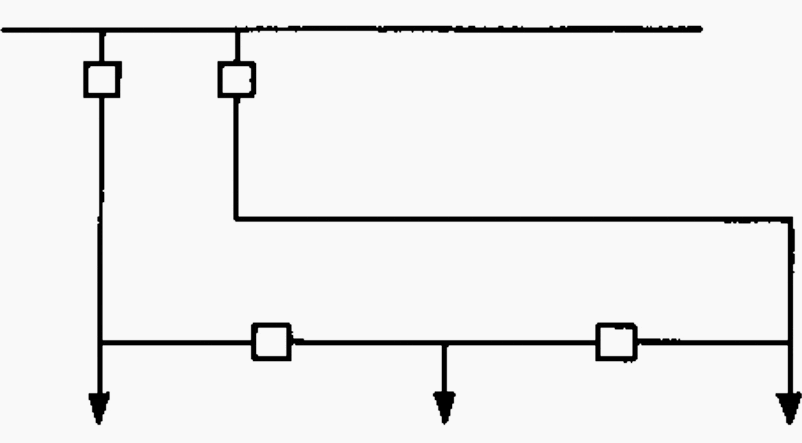
Figure 3(b) shows a further variation with no sectionalizing points. Scarcely any of the loop-feeder benefits remain. The service reliability is about the same as is provided by a single radial feeder, except that a feeder circuit breaker can be maintained without interrupting any load.

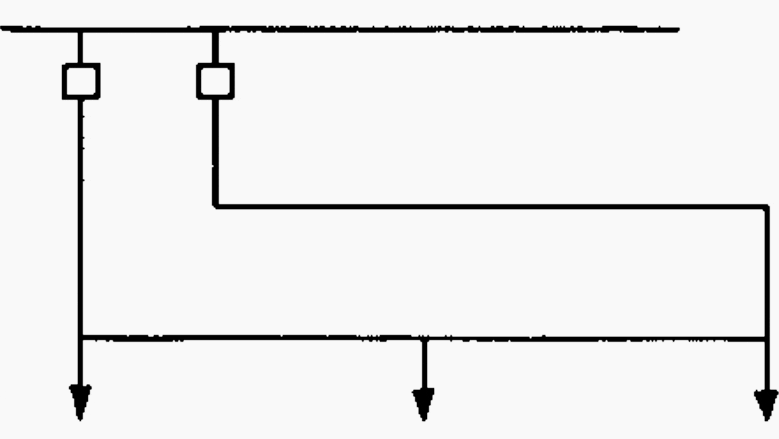
Another variation of a good loop-feeder arrangement is the one illustrated by Figure 3(c). As it was true for Figure 3(b), a single fault drops all
load. Service continuity for half the load can be obtained by operating the loop normally with a central sectionalizing switch open.
Following a short circuit, service to all the load can be reestablished by isolating the faulted section. The arrangement can serve the same complement of substations that can be served by a single radial feeder without needing individual protection of the substation transformers.
Without further analysis this arrangement appears to have attained fair service reliability with a moderate cost increase. However, most operating engineers will reject this system for cable circuits using metal-enclosed disconnects at the sectionalizing points because there are serious hazards involved in the switching operations likely to bc followed after a short circuit has occurred.

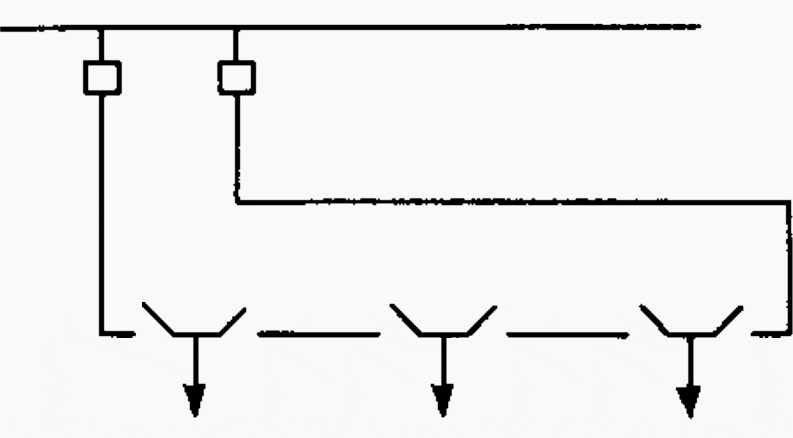
Whether the loop was open or closed when the fault occurred, the problem remains to find the section in trouble so that service can be restored to all load points. While it is not the best procedure, a common routine involves energizing the feeder from one end by repeated trial, after adding a section at a time, until the faulty section is located by immediate tripping of the source circuit breaker.
These operations present repeated opportunities to make switching mistakes. Even if the operator appreciates the hazard, there is still the temptation to energize the sections one at a time by means of the manual disconnects. These switches are also hazardous to operate under normal conditions because every section of a closed loop usually carries current.
A loop feeder carried on open overhead lines with structure or pole-mounted disconnects for sectionalizing is much safer. One difference is that short circuits on overhead lines are more often temporary than permanent.
The more important difference is that any switch failure is considerably less likely to injure an operator because of the remote operation.
Precautions for loop and parallel feeder layouts
Several precautions should be observed in loop and parallel feeder layouts. It is well to avoid compound loops-those with more than two source circuit breakers or with more than one path from one of two source circuit breakers back to the other.
Loop systems such as these may develop in an attempt to relieve overloaded circuit conductors. This is seldom an efficient solution compared to starting a new single loop. The load division is difficult to calculate, requiring close estimates of circuit impedance and assumed fixed loads at each load point.
Normal load variations and load growth can cause unexpectedly wide changes in the load division, and compound loops therefore tend to give only temporary relief at best. Other compound-loop systems simply grow without sound planning. They tend to be associated with poor load division, poor protection, and compromised service. Particularly where disconnects are used instead of circuit breakers, operation is more complicated and therefore more hazardous.
It was implied earlier that tie feeders do not supply load points between the two sources. This arrangement, combining the usual functions of tie and loop feeders, is sometimes advantageous. At the same time, certain complications and compromises of such a dual-purpose circuit should be recognized and weighed before finally deciding in favor of it.
Listed below are several possible shortcomings:
- The metering of load transferred between sources is more complicated.
- Additional protection at the load points may be needed to avoid opening the tie circuit on load-tap fault.
- If synchronism is maintained by t,he tie circuit, suitable precautions must be taken to prevent closing the tie by any sectionalizing circuit breaker because it will not be feasible to install synchronizing provisions at the several sectionalizing points.
Another precaution applies equally to parallel and loop feeders. These arrangements may complete a closed circuit around a bus-tie circuit breaker or a current-limiting reactor when the source circuit breakers are connected t o different buses. Such connections are often overlooked in system design work.
It is obviously a mistake to short-circuit current-limiting reactors by a feeder arrangement, and it is at least questionable to have a bus-tie circuit breaker short-circuited by independent primary switching operations at one or more remote points in the system.
Sources: Industrial Power Systems Handbook by Donald Beeman















![Toni Kroos là ai? [ sự thật về tiểu sử đầy đủ Toni Kroos ]](https://evbn.org/wp-content/uploads/New-Project-6635-1671934592.jpg)


